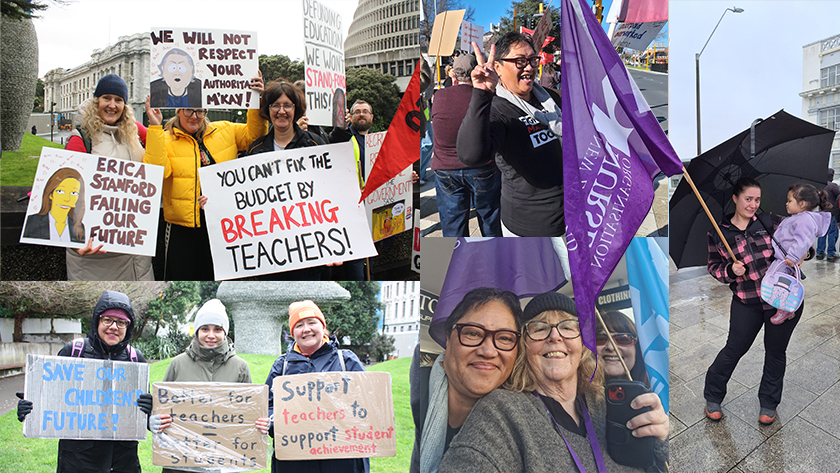Nurses supporting teachers out on strike. Photo credit: kaitiaki.org.nz
The coalition of chaos has, under urgency, passed legislation and prescribed policy that has brutalised the public service. There have been outright lies from government ministers intervening into the negotiations by releasing public statements, and within the negotiations, we have a government that refuses to talk about anything other than a below inflation offer, and sidelines demands around working conditions.
The tone of these negotiations was well explained by New Zealand Nurses Organisation chief executive Paul Goulter who stated to RNZ on 4 July that Health NZ has “given very little, if anything” and that this
really throws into doubt the sincerity of the government in trying to settle this. We have had clear indication the government is involved – and is increasingly involved – in directing the course of these negotiations. It’s not bargaining. It’s just being told what you’re going to get and that’s it
Nurses
After a year of failed negotiations, nurses have been offered 3.5 percent over three years. In regards to the offer, Minister Simeon Brown stated that “the average salary for a registered nurse is now over $125,000 a year”. This exemplifies the government approach: tell outright lies using inflated numbers, gaslighting workers into accepting the offer. The highest step of pay for a nurse is $106,739 according to their pay scale. A 3.5 percent pay rise over three years is atrocious when inflation is 2.7 percent. But some of the worst gaslighting has been over the refusal to guarantee safe staffing requirements.
Te Whatu Ora last year implemented new staffing rules, ending double shifts, limiting sick cover, and refusing to hire new staff across the country. It has consistently stated since last year that all hospitals are fully staffed. This is despite their own measurements in the “care capacity demand management data”, which tracks safe staffing levels. This data was held back from an Official Information Act request from the union and only released after the intervention of the Ombudsman. The report showed that day shifts in all wards last year were understaffed 51 percent of the time.
It’s this chronic understaffing that lies at the heart of the dispute. Health Minister Simeon Brown claims that they are hiring more nurses, and yet only 45 percent of all nursing graduates were hired this year, when normally that figure would be 80-90 percent. Nurses have been yelling from the rooftops about the chronic understaffing making an acceptable level of care impossible.
Doctors
It has been a similar story for the doctors in the Association of Salaried Medical Specialists (ASMS). Another year of failed negotiations, with Te Whatu Ora now referring the negotiations to the Employment Relations Authority to overrule the bargaining process, claiming the union has acted in bad faith. While pay offers have been made, every one of them was a pay cut in real terms. Again, the real issues are indicated by ASMS Executive Director Sarah Dalton: “We haven’t had any meaningful response from the employer about workforce planning, about investment in salaried staff, about how they plan to address widespread shortages”.
While Te Whatu Ora dithers about punishing the ASMS instead of negotiating, emergency department doctors have penned an open letter pleading for more help for struggling EDs across the country. In major hospitals such as Christchurch, their emergency departments are hitting code red almost every day, the highest code of overload.
Christchurch ED doctor Dominic Fleischer stated in an interview about that letter that
Patients are dying now really because of substandard care. Patients dying in the waiting room and corridors or who leave and literally drop dead in the car park… We’re in code red every day… Here and now, we need more resources. EDs across the country need more doctors, more nurses and more space.
It is inconvenient truths like these that have led to Minister Brown proposing a law change in the Pae Ora (Healthy Futures) Act to effectively gag health workers from speaking out about working conditions in the New Zealand Healthcare system.
Firefighters
The New Zealand Professional Firefighters Union (NZPFU) have overwhelmingly rejected their last appalling offer of just 5.1 percent over three years. Key in the negotiations has been Fire and Emergency NZ consistently refusing to talk about health and safety concerns and the appalling state of fire appliances. Multiple times this year, key fire appliances have broken down on the job or on the way to other jobs, leaving emergency workers and the people they help in danger. Of the 29 aerial appliances in the country, at least eight are out entirely needing repairs, leaving our cities vulnerable to multi-story fires. These shortages will cost lives.
Primary Teachers
Primary teachers, principals, school support staff, and Ministry of Education specialist staff, in a historic first, have all gone on strike after another year of failed negotiations. None of their offers match cost of living increases, with primary teachers offered just 3 percent over three years. Continuing the running theme, all other issues have been forced off the bargaining table by the government. The bargaining team has ignored the calls for more support in the classroom with funding for teacher aides, and ignored a call for Te Tiriti to be valued and upheld in education, and for more support for te reo Māori.
Secondary Teachers
Post-Primary Teachers’ Association (PPTA) members have also rejected a 4.6 percent offer and are continuing strike action this month. After the previous offer, Judith Collins had stated on multiple media reports that after just ten years, teachers can get up to $147,000 a year with management units. More lies: in fact, a secondary teacher’s top step of the pay scale is $103,086.
The offer included nothing on the claims for increased pastoral care to support students who spent their formative years in lockdown while dealing with an increasingly chaotic world. No support to our Pasifika Teachers and Kaiako Māori for all the extra community support they have to do. There is also no offer for curriculum advisers despite the vast changes to the curriculum and NCEA they are ramming through. What was included was an increase of callback days to 18 days per year. These are days where teachers are called back into school to work, effectively working for free. They also cut out the reimbursement claims for childcare and transport that have been standard since callback days were originally introduced.
Both primary and secondary teachers were professions that were well along the pay equity process, with a ruling due to be completed by the end of the year before Brooke Van Velden’s scrapping of pay equity claims. The partial strikes law, also brought in by Van Velden, has increased the burden on unions taking action. Massive public funding has been going towards failed privatised charter schools, and yet absolutely no budgeting has been done for the NCEA changes that have been announced. Teachers will be expected to make this new unfair system work for free while dealing with increasing pastoral pressures and increasing staff shortages.
Sir Brian Roche
Each of these unions are not directly bargaining with their ministries or departments. For the first time since 1997, the Public Service Commissioner Sir Brian Roche has taken a much more active role in bargaining, enforcing the government line that there is no money. He has gone further, denigrating those public service professions in public statements and written letters to boards of trustees expressing his opinion. This is unprecedented in what is normally a non-partisan role of Public Services Commissioner.
Underpinning negotiations in New Zealand is the article of good faith bargaining, where each side is committed to finding common ground. This is completely gone from the government and seems a direct result of Sir Brian Roche’s intervention in all the negotiations. The ministries in charge seem to be working off a “take it or leave it” approach. This is true of their approach to pay and to their sidelining of issues outside of pay. Staffing, Tiriti justice, functioning workplaces, and equipment are all non-negotiables for the Government. However, the need for these is non-negotiable for these workers.
Since his appointment last year, Sir Brian Roche has furiously whipped through the public service, pushing for more risk to get more value out of the public service. In a speech made in February about how he seeks to reorient the public service, he stated, “We need to create a sense of urgency, a war time focus every day as it were, and leave the hardwired architecture behind. The Public Service is often at its best in times of crisis.”
It seems he has created that atmosphere of crisis. We have all received effectively the same edict: Do more with less while we run the system into the ground and force ideological changes, all to make it easier to privatise. As detailed in another article in this paper, this battle against the lies and manipulations of the Government is a battle for the survival of the public service.









